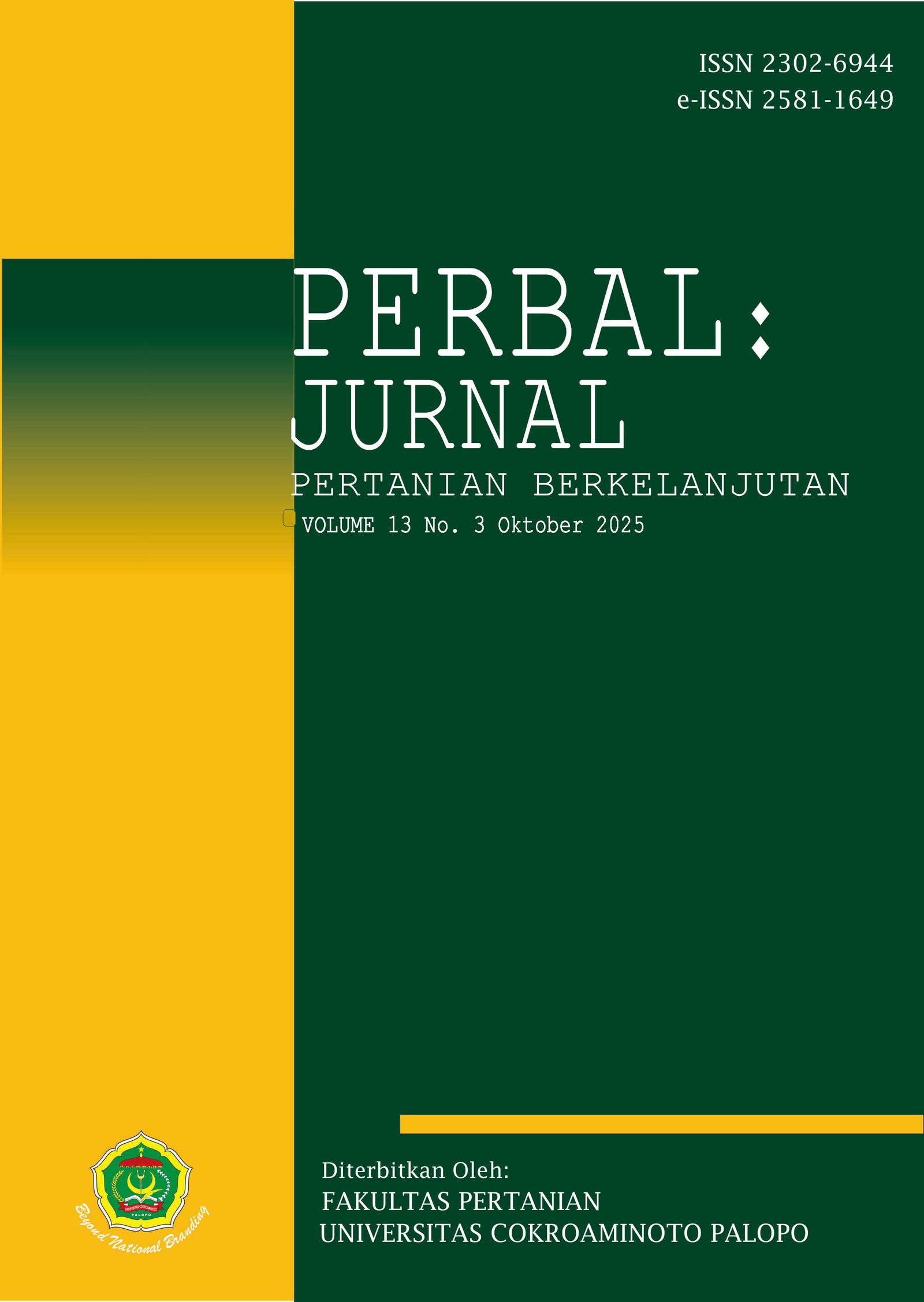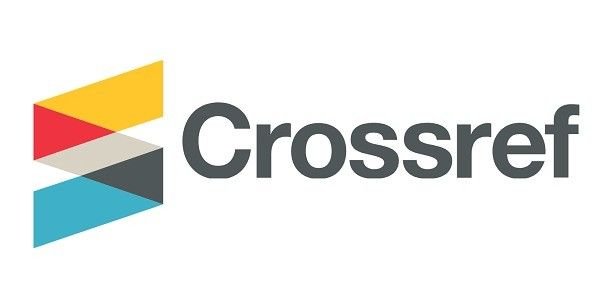Potensi Bahan Tambahan pada Pestisida Nabati Daun Pepaya Terhadap Hama dan Kerusakan Daun Kangkung Cabut (Ipomoea reptans Poir)
Additive Effects of Papaya Leaf Botanical Pesticides on Pest Control and Leaf Protection in Upland Water Spinach (Ipomoea reptans Poir)
DOI:
https://doi.org/10.30605/perbal.v13i3.6987Keywords:
Daun pepaya, pestisida nabati, kangkung cabut, serai, senyawa aktifAbstract
Penelitian ini bertujuan untuk mengevaluasi efektivitas penambahan bawang putih, serai, dan daun sirsak dalam formulasi pestisida nabati berbahan dasar daun pepaya terhadap penurunan jumlah hama dan kerusakan daun pada tanaman kangkung cabut (Ipomoea reptans Poir). Penelitian ini menggunakan metode eksperimen lapangan dengan Rancangan Acak Kelompok (RAK) yang terdiri atas lima taraf perlakuan dan lima ulangan, sehingga terdapat 25 satuan percobaan. Perlakuan terdiri dari P0 (kontrol); P1 (daun pepaya); P2 (daun pepaya + bawang putih), P3 (daun pepaya + serai), dan P4 (daun pepaya + daun sirsak). Pestisida nabati diformulasikan melalui proses penghalusan bahan aktif dalam 300 mL air, diikuti inkubasi selama tiga hari, penyaringan, dan pengenceran hingga 1 liter. Penanaman kangkung cabut dilakukan pada bedengan berukuran 1 × 1 meter dengan perlakuan budidaya standar, meliputi penyiraman, penyiangan, dan pemupukan dasar. Pestisida nabati diaplikasikan dengan metode penyemprotan sebanyak dua kali, yaitu pada minggu ketiga dan keempat setelah tanam, pada sore hari. Parameter yang diamati meliputi persentase penurunan jumlah hama serta kerusakan daun. Data yang diperoleh dianalisis secara deskriptif untuk menggambarkan pengaruh aplikasi pestisida nabati terhadap populasi hama dan tingkat kerusakan tanaman kangkung. Perlakuan paling optimal diperoleh dari kombinasi daun pepaya dan serai (P3), yang mampu menurunkan jumlah hama hingga 87,5% dan dapat menekan kerusakan daun dibandingkan perlakuan lainnya. Masih ditemukan tanda-tanda serangan berupa bercak cokelat dan bekas gigitan pada beberapa perlakuan, yang menunjukkan bahwa efektivitas pestisida nabati turut dipengaruhi oleh stabilitas senyawa aktif yang digunakan.
This study aimed to evaluate the effectiveness of adding garlic, lemongrass, and soursop leaves to a plant-based pesticide formulation using papaya leaves as the main ingredient in reducing pest populations and leaf damage in upland water spinach (Ipomoea reptans Poir). The research was conducted through a field experiment using a Randomized Complete Block Design (RCBD) consisting of five treatments and five replications, resulting in 25 experimental units. The treatments included P0 (control), P1 (papaya leaves), P2 (papaya leaves + garlic), P3 (papaya leaves + lemongrass), and P4 (papaya leaves + soursop leaves). The botanical pesticide was formulated by blending the active ingredients with 300 mL of water, followed by incubation for three days, filtration, and dilution to a final volume of 1 liter. Upland water spinach was cultivated on plots measuring 1 × 1 meters using standard cultivation practices, including watering, weeding, and base fertilization. The pesticide was applied twice by spraying, in the third and fourth weeks after planting, during the late afternoon. Observed parameters included the percentage reduction in pest numbers and leaf damage. The most effective treatment was P3 (papaya leaves + lemongrass), which reduced pest populations by 87.5% and significantly suppressed leaf damage compared to other treatments. However, signs of pest activity such as brown spots and bite marks were still observed in some treatments, indicating that the effectiveness of the botanical pesticide was also influenced by the stability of the active compounds used.
Downloads
References
Azizah, L.S., Hastuti, S., Musthofa, A.T., & Wibowo, E.S. (2019). Effectiveness of papaya leaf extract (Carica papaya L.) to control ectoparasite Argulus on common carp (Cyprinus carpio). IOP Conference Series: Earth and Environmental Science, 236(1), 012106. https://doi.org/10.1088/1755-1315/236/1/012106. DOI: https://doi.org/10.1088/1755-1315/236/1/012106
Bell, H.A., Cuthbertson, A.G., & Audsley, N. (2015). The potential use of allicin as a biopesticide for the control of the house fly, Musca domestica L. International Journal of Pest Management. 62(2). https://doi.org/10.1080/09670874.2015.1120363. DOI: https://doi.org/10.1080/09670874.2015.1120363
Chen, W., & Viljoen, A.M. (2022). Geraniol – A review update. South African Journal of Botany, 150, 1205–1219. https://doi.org/10.1016/j.sajb.2022.09.012. DOI: https://doi.org/10.1016/j.sajb.2022.09.012
Eden, W.T., Alighiri, D., Supardi, K.I., & Cahyono, E. (2020). The mosquito repellent activity of the active component of air freshener gel from Java citronella oil (Cymbopogon winterianus). Journal of Parasitology Research, 2020, Article ID 9053741, 5 pages. https://doi.org/10.1155/2020/9053741. DOI: https://doi.org/10.1155/2020/9053741
El-Nahhal, I., & El-Nahhal, Y. (2021). Pesticide residues in drinking water, their potential risk to human health and removal options. Journal of Environmental Management, 299, 113611. https://doi.org/10.1016/j.jenvman.2021.113611. DOI: https://doi.org/10.1016/j.jenvman.2021.113611
Fauzah. (2021). Aplikasi pestisida nabati ekstrak daun pepaya terhadap hama kutu daun (Aphis gossypii) pada tanaman Giri Matang (Citrus maxima L.). Jurnal Sains Pertanian, 4(1), 1–4. https://doi.org/10.51179/jsp.v4i1.1700. DOI: https://doi.org/10.51179/jsp.v5i1.1700
Giuliano, G., Campolo, O., Forte, G., Urbaneja, A., Pérez-Hedo, M., Latella, I., Palmeri, V., & Giunti, G. (2024). Insecticidal activity of Allium sativum essential oil-based nanoemulsion against Spodoptera littoralis. Insects, 15(7), 476. https://doi.org/10.3390/insects15070476 DOI: https://doi.org/10.3390/insects15070476
Golubkina, N., Zayachkovsky, V., Sheshnitsan, S., Skrypnik, L., Antoshkina, M., Smirnova, A., Fedotov, M., & Caruso, G. (2022). Prospects of the application of garlic extracts and selenium and silicon compounds for plant protection against herbivorous pests: A review. Agriculture, 12(1), 64. https://doi.org/10.3390/agriculture12010064. DOI: https://doi.org/10.3390/agriculture12010064
Gunawan, F.H., Syah, B., & Muharam, M. (2025). Pengaruh pestisida ekstrak daun pepaya terhadap ulat grayak (Spodoptera litura F.) pada tanaman sawi kailan (Brassica oleracea var. new veg gin) dengan sistem hidroponik NFT. Jurnal Agroplasma, 12(1), 329–334. https://doi.org/10.36987/agroplasma.v12i1.7429.
Hardiansyah, M.Y., Al Ridho, A.F., & Nurhidayat. (2020). The effect of garlic (Allium sativum) extract pesticides in repelling rice eating bird pests. Indonesian Journal of Agricultural Research, 3(3), 145–152. https://doi.org/10.32734/injar.v3i3.3947. DOI: https://doi.org/10.32734/injar.v3i3.3947
Hasim, H., Nasution, S.P., Kurniawati, S.O., & Rachmawati, I. (2020). Aktivitas sitotoksik sitral serai sebagai antikanker payudara MCM B2 (Cytotoxic activity of citral from Cymbopogon nardus as anticancer of MCM B2 cell). Current Biochemistry, 7(1), 29–36. https://doi.org/10.29244/cb.7.1.4. DOI: https://doi.org/10.29244/cb.7.1.4
Herawati, M., & Timur, N.P.V.T. (2022). The use of papaya (Carica papaya) leaf extract as a natural insecticide to controlling flies (Stomoxys sp.) in cattle at Manokwari West Papua. Bantara Journal of Animal Science, 4(1), 19–23. https://doi.org/10.32585/bjas.v4i1.2317. DOI: https://doi.org/10.32585/bjas.v4i1.2317
Hidalgo, C., Reyes, F., Rojas, L., & Ramírez, A. (2021). Evaluation of the insecticidal activity of squamocin and rolliniastatin-2 and their mixture with lambda-cyhalothrin against Spodoptera frugiperda (Lepidoptera: Noctuidae) larvae. Insects, 12(4), 440. https://doi.org/10.3390/insects12040440
Hincapié-Llanos, C. A., Lopera-Arango, D., & Ceballos-Giraldo, M. (2008). Insecticidal activity of Annona muricata (Anonaceae) seed extracts on Sitophilus zeamais (Coleoptera: Curculionidae). Revista Colombiana De Entomología, 34(1), 76–82. https://doi.org/10.25100/socolen.v34i1.9254. DOI: https://doi.org/10.25100/socolen.v34i1.9254
Jovanović, J., Ćirković, J., Radojković, A., Tasić, N., Mutavdžić, D., Branković, G., & Branković, Z. (2024). Enhanced stability of encapsulated lemongrass essential oil in chitosan-gelatin and pectin-gelatin biopolymer matrices containing ZnO nanoparticles. International Journal of Biological Macromolecules, 275(Part 2), 133335. https://doi.org/10.1016/j.ijbiomac.2024.133335. DOI: https://doi.org/10.1016/j.ijbiomac.2024.133335
Juleha, S., Afifah, L., Sugiarto, T., Surjana, T., & Yustiano, A. (2022). Potensi daun pepaya (Carica papaya L.) sebagai racun kontak dan penolak makan terhadap Spodoptera frugiperda. Jurnal Agrotech, 12(2), 66–72. https://doi.org/10.31970/agrotech.v12i2.95. DOI: https://doi.org/10.31970/agrotech.v12i2.95
Liem, J. (2021). Biomonitoring pajanan pestisida organofosfat pada pekerja pertanian. Jurnal Kedokteran Meditek, 27(1), 88–94. https://doi.org/10.36452/jkdoktmeditek.v27i1.1967. DOI: https://doi.org/10.36452/jkdoktmeditek.v27i1.1967
Lu, Y., Zhong, J., Wang, Z., Liu, F., & Wan, Z. (2013). Fumigation toxicity of allicin against three stored product pests. Journal of Stored Products Research, 55, 48–54. https://doi.org/10.1016/j.jspr.2013.08.002. DOI: https://doi.org/10.1016/j.jspr.2013.08.002
Moniharapon, D., Nindatu, M., & Bastian, A. (2021). The effect of lemongrass extract (Cymbopogon citratus L.) on pest mortality of Plutella xylostella L. in mustard plants (Brassica juncea L.). Rumphius Pattimura Biological Journal, 3(2), 34–38. https://doi.org/10.30598/rumphiusv3i2p034-038. DOI: https://doi.org/10.30598/rumphiusv3i2p034-038
Moreira da Silva, T.L., Beltrame, F.L., & Ferrari, P.C. (2024). Lemongrass essential oil micro- and nanoencapsulation for industrial application: Production techniques and potential applications. Archiv der Pharmazie, 357(6), e2300726. https://doi.org/10.1002/ardp.202300726. DOI: https://doi.org/10.1002/ardp.202300726
Morgan, E.D., & Wilson, I.D. (1999). 8.05 - Insect hormones and insect chemical ecology. In Comprehensive natural products chemistry, 8, 263–375. Elsevier. https://doi.org/10.1016/B978-0-08-091283-7.00053-9. DOI: https://doi.org/10.1016/B978-0-08-091283-7.00053-9
Nguyen, P.T.N., Vo, T.T., Tran, T.Y.N., Le, T. H.N., Mai, H.C., Tran, T.T., & Long, G.B. (2021). Encapsulation efficiency and thermal stability of lemongrass (Cymbopogon citratus) essential oil microencapsulated by the spray-drying process. Food Research, 5(1), 195–202. https://doi.org/10.26656/fr.2017.5(1).300. DOI: https://doi.org/10.26656/fr.2017.5(1).300
Oguh, C.E., Okpaka, C.O., Ubani, C.S., Okekeaji, U., Joseph, P.S., & Amadi, E.U. (2019). Natural pesticides (biopesticides) and uses in pest management: A critical review. Asian Journal of Biotechnology and Genetic Engineering, 2(2), 126–143. https://journalajbge.com/index.php/AJBGE/article/view/37.
Pastor, S.J.R. (2024). Evaluation of botanical leaf extracts in the cultivation of tomato (Solanum lycopersicum). International Journal of Biosciences, 25(1), 106–116. https://doi.org/10.12692/ijb/25.1.106-116. DOI: https://doi.org/10.12692/ijb/25.1.106-116
Plata-Rueda, A., Martínez, L.C., Santos, M.H.D., Fernandes, F.L., Wilcken, C.F., Soares, M.A., Serrão, J.E., & Zanuncio, J.C. (2017). Insecticidal activity of garlic essential oil and their constituents against the mealworm beetle, Tenebrio molitor Linnaeus (Coleoptera: Tenebrionidae). Scientific Reports, 7, 46406. https://doi.org/10.1038/srep46406. DOI: https://doi.org/10.1038/srep46406
Purba, R.M., & Muliarta, I.N. (2024). Papaya leaves as a plant based pesticide to control pests and plant diseases. Formosa Journal of Sustainable Research, 3(7), 1455–1476. https://doi.org/10.55927/fjsr.v3i7.10314. DOI: https://doi.org/10.55927/fjsr.v3i7.10314
Purnawan, P. (2023). Repellency of citronella essential oil in controlling pests in plants. Journal Eduvest, 4(9), 8317–8330. https://doi.org/10.59188/eduvest.v4i9.1752. DOI: https://doi.org/10.59188/eduvest.v4i9.1752
Rahman, G.K.M.M., & Motoyama, N. (2000). Repellent effect of garlic against stored product pests. Journal of Pesticide Science, 25(3), 247–252. https://doi.org/10.1584/jpestics.25.247. DOI: https://doi.org/10.1584/jpestics.25.247
Rahayu, K.D., Thei, R.S.P., & Sarjan, M. (2023). Keragaman dan kelimpahan hama pada tanaman kangkung air (Ipomoea aquatica F.) di Kabupaten Lombok Barat. Agroteksos, 33(2), 645–653. https://doi.org/10.29303/agroteksos.v33i2.968. DOI: https://doi.org/10.29303/agroteksos.v33i2.968
Ramadan, A.R.S., & Yuliani. (2025). Effectiveness of soursop leaf and seed extract (Annona muricata) and its combination on antifeeding activity and mortality of Spodoptera frugiperda larvae. LenteraBio, 14(1), 27–34. https://doi.org/10.26740/lenterabio.v14n1.p27-34.
Rinto, R., Nugroho, G.D., Sari, Y., & Arisviani, A. (2024). Evaluation of soursop (Annona muricata linn) leaf extract as a preventative measure against flies contamination in salted fish. BIO Web of Conferences, 147, 01005. https://doi.org/10.1051/bioconf/202414701005. DOI: https://doi.org/10.1051/bioconf/202414701005
Rohim, A.N., Poerwanto, M.E., Solichah, C., & Holford, P. (2023). Repellency of lemongrass extract (Cymbopogon nardus) in solid and liquid formulation on Diaphorina citri and Menochilus sexmaculatus. Proceedings of the 2nd ICAFE 2023. BIO Web of Conferences, 69, 01030. https://doi.org/10.1051/bioconf/20236901030. DOI: https://doi.org/10.1051/bioconf/20236901030
Rumende, C.F.A., Salaki, C.L., & Kaligis, J.B. (2021). Pemanfaatan ekstrak daun pepaya (Carica papaya L.) terhadap hama Spodoptera frugiperda J.E. Smith (Lepidoptera: Noctuidae). Cocos, 13(1), Artikel e32482. https://doi.org/10.35791/cocos.v2i2.32482
Saidi, I.A., Azara, R., Ramadhani, S.N., & Yanti, E. (2022). Nutrisi dan komponen bioaktif pada sayuran daun. UMSIDA Press. DOI: https://doi.org/10.21070/2022/978-623-464-017-5
Salessy, S., Awan, A., & Wael, S. (2022). Effectiveness of soursop leaf extract (Annona muricata L.) on the mortality of graycool caterpillars (Spodoptera litura). Rumphius Pattimura Biological Journal, 4(1), 26–33. https://doi.org/10.30598/rumphiusv4i1p026-033 DOI: https://doi.org/10.30598/rumphiusv4i1p026-033
Sarah, M., Ardiansyah, D., Misran, E., & Madinah, I. (2023). Extraction of citronella oil from lemongrass (Cymbopogon winterianus) by sequential ultrasonic and microwave-assisted hydro-distillation. Alexandria Engineering Journal, 70, 569–583. https://doi.org/10.1016/j.aej.2023.03.019 DOI: https://doi.org/10.1016/j.aej.2023.03.019
Scorza, F. A., Beltramim, L., & Bombardi, L. M. (2023). Pesticide exposure and human health: Toxic legacy. Clinics (São Paulo), 78, 100249. https://doi.org/10.1016/j.clinsp.2023.100249. DOI: https://doi.org/10.1016/j.clinsp.2023.100249
Shadana, M., Lesmana, S.D., & Hamidy, M.Y. (2014). Efek larvasida ekstrak etanol daun pepaya (Carica papaya) terhadap larva Aedes aegypti. Jurnal Online Mahasiswa Fakultas Kedokteran Universitas Riau, 1(2), 1–14.
Siahaya, V.G., & Rumthe, R.Y. (2014). Uji ekstrak daun pepaya (Carica papaya) terhadap larva Plutella xylostella (Lepidoptera: Plutellidae). Agrologia, 3(2), 112–116. DOI: https://doi.org/10.30598/a.v3i2.251
Siregar, W. (2025). Identifikasi Serangga Hama dan Penggunaan Insektisida Bahan Aktif Metomil 40% pada Kangkung Darat. Skripsi. Universitas Islam Negeri Sultan Syarif Kasim Riau. Fakultas Pertanian dan Peternakan.
Skendžić, S., Zovko, M., Živković, I. P., Lešić, V., & Lemić, D. (2021). The impact of climate change on agricultural insect pests. Insects, 12(5), 440. https://doi.org/10.3390/insects12050440 DOI: https://doi.org/10.3390/insects12050440
Sulastri, I. K., Muhibbuddin, Khairil, Djufri, & Abdullah. (2023). Pengaruh ekstrak daun pepaya (Carica papaya L.) sebagai pestisida alami pada mortalitas hama Aphis gossypii Glover. Jurnal Ilmiah Mahasiswa Pendidikan Biologi FKIP USK, 8(1), 16–24.
Suryani, D., Pratamasari, R., Suyitno, S., & Maretalinia, M. (2020). Perilaku petani padi dalam penggunaan pestisida di Desa Mandalahurip Kecamatan Jatiwaras Kabupaten Tasikmalaya. Window of Health: Jurnal Kesehatan, 0(0), 95–103. https://doi.org/10.33368/woh.v0i0.285. DOI: https://doi.org/10.33368/woh.v0i0.285
Tang, Y., Li, H., & Song, Q. (2024). Lemongrass essential oil and its major component citronellol: Evaluation of larvicidal activity and acetylcholinesterase inhibition against Anopheles sinensis. Parasitology Research, 123(9), 315. https://doi.org/10.1007/s00436-024-08338-3. DOI: https://doi.org/10.1007/s00436-024-08338-3
Telaumbanua, M., Savitri, E.A., Shofi, A.B., Suharyatun, S., Wisnu, F.K., & Haryanto, A. (2021). Plant-based pesticide using citronella (Cymbopogon nardus L.) extract to control insect pests on rice plants. IOP Conference Series: Earth and Environmental Science, 739(1), 012071. https://doi.org/10.1088/1755-1315/739/1/012071. DOI: https://doi.org/10.1088/1755-1315/739/1/012071
Thanawat, W., Phutdhawong, W., Sukhthankar, M., & Limmatvapirat, C. (2020). Comparative chemical stability of citral in ethanolic extracts of Cymbopogon citratus (lemongrass) and commercial lemongrass essential oil. Acta Chromatographica, 32(3), 203–210. https://doi.org/10.1556/1326.2020.00755. DOI: https://doi.org/10.1556/1326.2020.00755
Ujjan, A.A., Khanzada, M.A., & Shahzad, S. (2014). Insecticide and papaya leaf extract toxicity to mustard aphid (Lipaphis erysimi Kal.). Journal of Agri Food and Applied Sciences, 2(2), 45–48.
Ujianhati, Z., & Amaano, F. (2021). Pengaruh ekstrak daun sirsak (Annona muricata L.) sebagai insektisida alami dalam membasmi lalat rumah (Musca domestica). Jurnal Education and Development, 9(2), 616–620.
Zhou, S., Yan, X., Qiao, X., Zhu, W., Lu, X., Zheng, Z., & Zhang, B. (2025). Evaluate the stability of synthesized allicin and its reactivity with endogenous compounds in garlic. NPJ Science of Food, 9, 18. https://doi.org/10.1038/s41538-025-00374-2. DOI: https://doi.org/10.1038/s41538-025-00374-2
Downloads
Published
Issue
Section
License
Copyright (c) 2025 Nurul Chairiyah, Ipun Ipun, Dwi Santoso, Nur Indah Mansyur, Nurmaisah Nurmaisah, Muh. Adiwena, Saat Egra, Muttaqien Muttaqien

This work is licensed under a Creative Commons Attribution 4.0 International License.
In submitting the manuscript to the journal, the authors certify that:
- They are authorized by their co-authors to enter into these arrangements.
- The work described has not been formally published before, except in the form of an abstract or as part of a published lecture, review, thesis, or overlay journal.
- That it is not under consideration for publication elsewhere,
- That its publication has been approved by all the author(s) and by the responsible authorities – tacitly or explicitly – of the institutes where the work has been carried out.
- They secure the right to reproduce any material that has already been published or copyrighted elsewhere.
- They agree to the following license and copyright agreement.
License and Copyright Agreement
Authors who publish with Onoma Journal: Education, Languages??, and Literature agree to the following terms:
- Authors retain copyright and grant the journal right of first publication with the work simultaneously licensed under Creative Commons Attribution License (CC BY 4.0) that allows others to share the work with an acknowledgment of the work's authorship and initial publication in this journal.
- Authors are able to enter into separate, additional contractual arrangements for the non-exclusive distribution of the journal's published version of the work (e.g., post it to an institutional repository or publish it in a book), with an acknowledgment of its initial publication in this journal.
- Authors are permitted and encouraged to post their work online (e.g., in institutional repositories or on their website) prior to and during the submission process, as it can lead to productive exchanges, as well as earlier and greater citation of published work.














